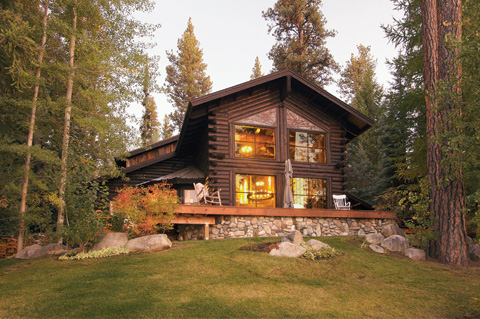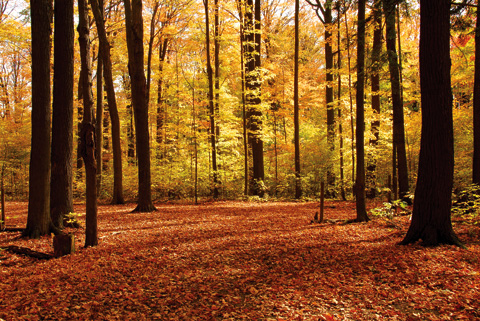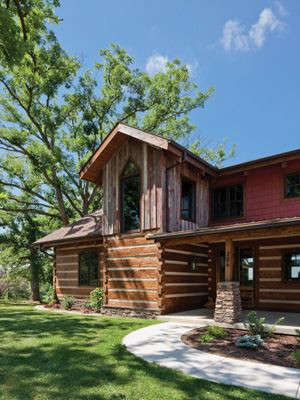You have been dreaming of this home for years. You have collected a binder full of ideas and sketches of what you envision your log home to include. And now you are looking for a building site. What should you be looking for when preparing to purchase property? Here are five important factors to consider when choosing your building site.
Where will you build? We all have a general idea of where we want to build our dream home. Maybe you envision your home tucked into trees on the side of a mountain or nestled on the rocky bank of a river. Are you considering building in an established community or looking for a particular piece of property in the wilds of the West? Whatever the case, an important factor to consider when choosing where to build is how you want to live in your home. Your needs will differ if you are planning a vacation home versus a permanent residence.

Bigstock
“Log homes thrive in their natural habitat—woods,” says Rob Whorton, director of marketing at Southland Log Homes in Irmo, South Carolina. “Other than that, log homes can be built anywhere any other type of home can be built.”
What is your budget? Remember, land is only a fraction of your home project costs—budgeting for the log package and the log home’s construction are vital ingredients to a successful financial plan. Having a rough idea of how much your dream home will cost gives you an idea of how much land you can afford. If you find the perfect location but it’s costlier than you’ve budgeted, you might consider cutting back on elements in your home plan.
Also, consider options that can utilize the site to its best advantages and save money in the long run. “Be aware that narrow, sloping lots have more basement and stone expense,” says Chris Wood, vice president of sales for Hearthstone, Inc., in Dandridge, Tennessee. “Wide and level lots over a crawl space are better for one-level log home living with wrap-around porches for protection.”
Is the land suitable? What are local community and government restrictions on building? Are there zoning ordinances or restrictions you should be aware of? What public utilities are available and what are you responsible for? If local utilities are unavailable, is the land conducive to a septic system or well being installed? Consider the condition of the land itself. Expenses can add up if you need to excavate rocks to accommodate a basement or install a retaining wall for a sloped piece of property.

Bigstock
Also consider access to your site. “A long driveway and home hidden from the main road is ideal, but consider a driveway that allows access with a 48-foot flatbed trailer. Shuttling long timbers on a gooseneck trailer is possible, but adds to expenses,” Chris says.
“Land purchasers should consider the slope of the land because it affects the type of foundation that will best be utilized. Some properties may need to be checked for rock underground as this may necessitate blasting to install the foundation—an expensive proposal,” says Rob. “Also, be sure to check that a lot can pass local requirements for septic systems.”
How will land be used? Are you looking for extra privacy on your property? Maybe you’re an avid gardener or want to enjoy outdoor activities, such as hiking, swimming, or cross-country skiing? If you are considering building in a developed community, choose one that has amenities tied to your interests, such as golfing or fishing. When choosing a property, plan accordingly for the land to accommodate your home, but also the activities you want to enjoy at your home.
Is the land eco-friendly? When looking for a piece of property, you might consider a site that is environmentally friendly. Do you have mature trees that can offer protection from the elements and help keep the home cool but not cause concern from falling into the home? Can you protect drainage patterns and plants on the property, keeping the land as native as possible? Does your site lend itself to a geothermal system or enable you to orient the home toward the sun to maximize solar energy?
“Green building on the lot shows up in the placement of trees, or the placement of the home around more mature trees. Trees are a great source of shade to help lower air conditioning costs in the summer and can shelter the home from cold north winds in the winter,” says Rob. “Users of solar panels will want to ensure unobstructed access of the sun for those panels. Serious green enthusiasts will also consider that the property can aid, or impede, geothermal systems and may even view the property from a wind turbine vantage point.”
“Log home construction by its nature is already mostly green—using naturally created native materials with minimal site waste. If owners have access to materials like recycled stone for foundations and retaining walls or tree limbs for railings, they can reuse these for the home,” says Chris. “Also, study prevailing weather patterns. Look for land formations, such as rocks, hills, or trees, that can divert or protect log walls from horizontal rain or driving snow.”
Before moving forward on a land purchase, take these factors into consideration and you just might find a site as perfect as the home you envision.


